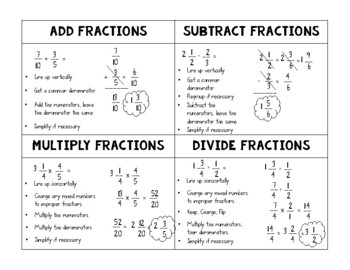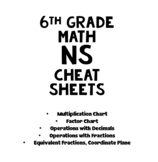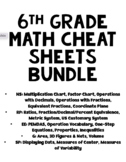Operations with Fractions and Equivalent Fractions Cheat Sheet
6th Grade Donuts
42 Followers
Grade Levels
4th - 7th
Subjects
Resource Type
Standards
CCSS4.NF.A.2
CCSS4.NF.B.3c
CCSS4.NF.B.4
CCSS5.NF.A.1
CCSS5.NF.B.4
Formats Included
- PDF
Pages
2 pages
6th Grade Donuts
42 Followers
What educators are saying
This resource was super supportive during our group times to support whole group and small group learning .
This is a very clear and easy to follow "cheat sheet." Several of my student's continue to access and use it several months later.
Also included in
- 6th Grade Math Cheat Sheets for the NS Standards. After we've learned each concept, I let my students use these whenever they want. It keeps them from getting stuck when we move on and helps them keep up!Cheat Sheets Included:Multiplication ChartFactors ChartOperations with FractionsOperations withPrice $1.50Original Price $2.00Save $0.50
- The Ultimate Cheat Sheet Bundle!Not everything needs to be memorized! Gift your students cheat sheets as you learn the standards throughout their 6th grade year. Use these as tools to use to help them master standards without getting stuck in the minutia.Cheat Sheets Included:•NS: Multiplication ChaPrice $13.50Original Price $15.00Save $1.50
Description
Everyone knows it's hard to remember operations with fractions and finding equivalent fractions! Gift your students these cheat sheets to support them as they internalize these processes.
Check out my 6th Grade Math NS Cheat Sheets for a bundle of more Number Systems Cheat Sheets.
Total Pages
2 pages
Answer Key
N/A
Teaching Duration
N/A
Report this resource to TPT
Reported resources will be reviewed by our team. Report this resource to let us know if this resource violates TPT’s content guidelines.
Standards
to see state-specific standards (only available in the US).
CCSS4.NF.A.2
Compare two fractions with different numerators and different denominators, e.g., by creating common denominators or numerators, or by comparing to a benchmark fraction such as 1/2. Recognize that comparisons are valid only when the two fractions refer to the same whole. Record the results of comparisons with symbols >, =, or <, and justify the conclusions, e.g., by using a visual fraction model.
CCSS4.NF.B.3c
Add and subtract mixed numbers with like denominators, e.g., by replacing each mixed number with an equivalent fraction, and/or by using properties of operations and the relationship between addition and subtraction.
CCSS4.NF.B.4
Apply and extend previous understandings of multiplication to multiply a fraction by a whole number.
CCSS5.NF.A.1
Add and subtract fractions with unlike denominators (including mixed numbers) by replacing given fractions with equivalent fractions in such a way as to produce an equivalent sum or difference of fractions with like denominators. For example, 2/3 + 5/4 = 8/12 + 15/12 = 23/12. (In general, 𝘢/𝘣 + 𝘤/𝘥 = (𝘢𝘥 + 𝘣𝘤)/𝘣𝘥.)
CCSS5.NF.B.4
Apply and extend previous understandings of multiplication to multiply a fraction or whole number by a fraction.





